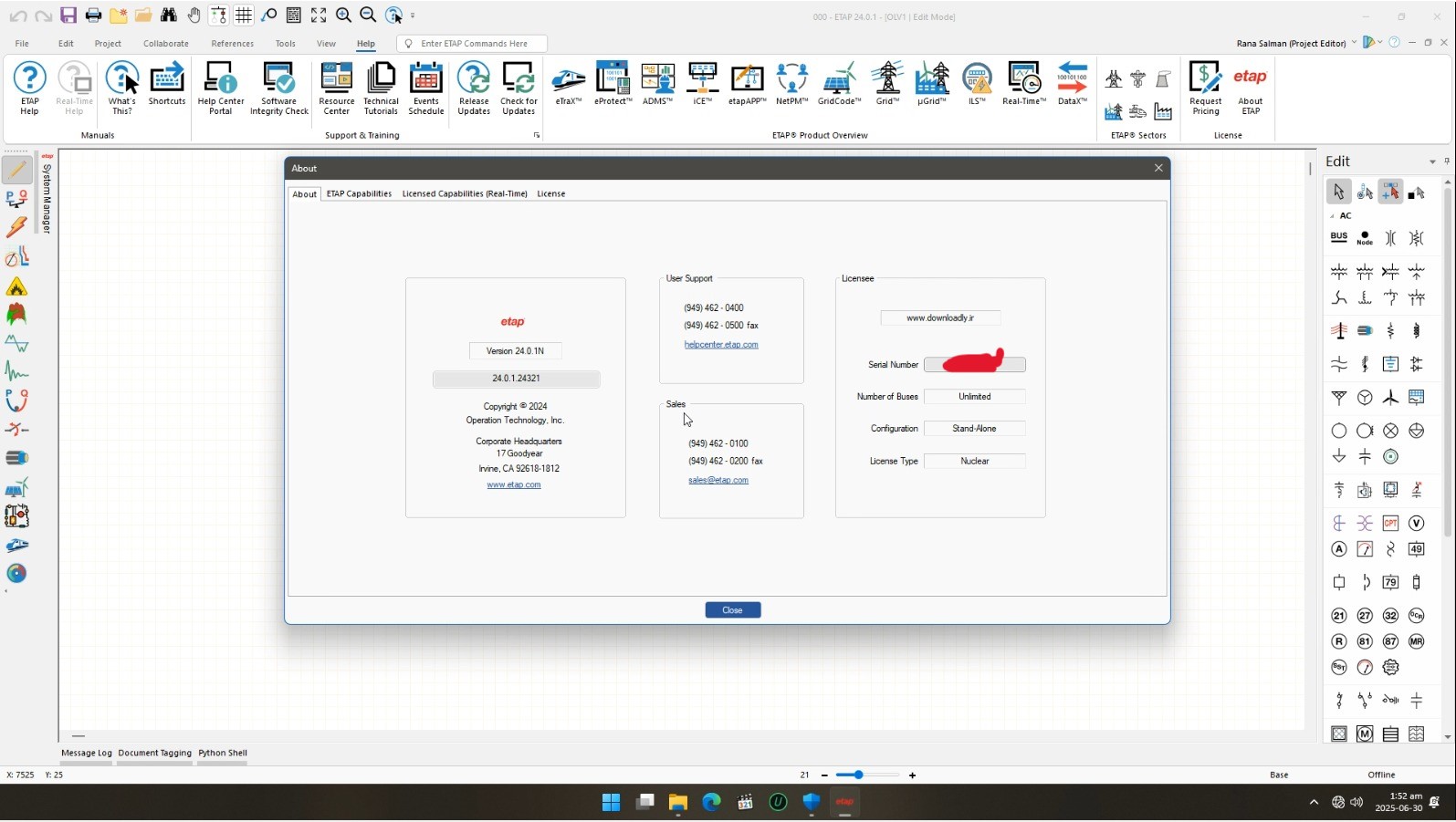Summary
ETAP V24 is one of the most powerful and widely used power system analysis software tools globally, designed to enhance the productivity and accuracy of electrical engineers in planning, operation, and automation. Known for its detailed simulations, accurate modeling, and real-time monitoring capabilities, ETAP V24 is the latest major release offering several significant enhancements and modules that transform how engineers work with electrical systems. From load flow analysis to arc flash hazard evaluations, this version continues to lead in terms of innovation and user efficiency, allowing professionals to visualize, predict, and optimize electrical networks in a safer and smarter way.
It is more than just a power system simulation tool; it’s a complete ecosystem for electrical engineers aiming to design, analyze, monitor, and optimize power systems with precision and safety. With significant enhancements in modeling accuracy, user interface, real-time monitoring, and safety compliance, this version redefines what engineers can achieve with a digital engineering platform. Whether you are working on utility networks, industrial plants, or smart building systems, It provides the flexibility, reliability, and advanced functionality needed to stay ahead in a competitive and ever-demanding energy sector.
Interface Improvements and Workflow Enhancements
One of the most noticeable upgrades in ETAP is the refined user interface which now offers a more intuitive layout, enhanced toolbar navigation, and dynamic search functionality to improve access to tools and modules. The new ribbon-style interface and customizable workspace layouts empower users to personalize their environment according to specific project needs, ultimately leading to faster execution and more efficient workflows. The improved drag-and-drop capability, smart command panel, and flexible screen arrangements help streamline the engineering process significantly while maintaining the software’s high-performance standards.
Expanded Modeling Capabilities and Libraries
It introduces new libraries and modeling capabilities that allow engineers to simulate even more complex electrical components with high precision. With thousands of pre-configured device templates, users can quickly build, analyze, and verify the performance of sophisticated power networks. Enhanced element modeling includes improvements in circuit breaker dynamics, transformer saturation, motor drive control, and renewable integration. Moreover, the unified equipment library enables consistent use of data across various modules such as protection, arc flash, and short circuit analysis, reducing redundancy and improving model accuracy.
ETAP V24 Lifetime License Proof



Faster Load Flow and Short Circuit Analysis
One of the key performance highlights of ETAP is the speed and efficiency of its load flow and short circuit analysis modules. The new power flow engine employs an optimized convergence algorithm that delivers faster and more stable results, even in large-scale electrical systems. Enhanced reporting tools and graphic displays enable engineers to interpret data visually through voltage contour maps, thermal overload indicators, and fault current distribution charts. Short circuit analysis benefits from updated compliance with IEEE and IEC standards, allowing engineers to automatically evaluate the system’s fault tolerance with high reliability and confidence.
Arc Flash Analysis and Safety Compliance
It provides industry-leading arc flash hazard analysis tools that help engineers assess potential danger zones, define personal protective equipment (PPE) boundaries, and comply with OSHA, NFPA 70E, and IEEE 1584-2018 standards. The arc flash module now includes improved incident energy calculation methods, automated label generation, and thermal damage assessment features. By simulating fault scenarios in real-time, users can better understand the severity of incidents and ensure optimal safety practices in industrial and commercial environments. The software also supports coordination studies and mitigation planning for both medium and low-voltage systems.
Transient Stability and Dynamic Simulation
Transient stability analysis is another advanced feature in ETAP that supports dynamic simulation of power systems under fault or switching conditions. With enhanced real-time simulation engines, engineers can now monitor the behavior of generators, exciters, and protective relays during disturbances. This is especially crucial for critical infrastructures like power plants, substations, and smart grids. It provides graphical visualization tools to observe rotor angle deviations, voltage oscillations, and system frequency responses, helping engineers validate their system’s resilience and design suitable control strategies for contingencies.
Real-Time Monitoring and Digital Twin Technology
A major breakthrough in ETAP is its integrated digital twin platform, which allows for continuous real-time monitoring and synchronization of the physical power system with its digital counterpart. By leveraging live data from SCADA, IoT, and telemetry systems, engineers can perform real-time load flow, contingency analysis, and fault detection. This capability enhances operational visibility, reduces downtime, and supports predictive maintenance. ETAP’s digital twin solution transforms traditional passive electrical networks into active, intelligent systems capable of self-correction and proactive energy management.
Utility and Smart Grid Networks
ETAP is extensively used by utility companies to design and manage large-scale transmission and distribution networks. Its smart grid features enable automated fault location, service restoration, and grid optimization. Engineers use the platform for renewable integration studies, substation automation, and voltage stability assessments, thereby ensuring uninterrupted power delivery to consumers. Its modular structure supports scalability for expanding power grids and is fully compatible with renewable resources such as solar, wind, and battery energy storage systems (BESS), making it ideal for future-ready grid environments.
Industrial and Manufacturing Facilities
Industries such as oil and gas, petrochemicals, mining, and steel rely on ETAP for their plant-wide electrical design, protection coordination, and risk mitigation strategies. The software’s ability to simulate black start operations, motor starting sequences, and harmonic distortion analysis allows facility managers to ensure smooth operations without unexpected outages. Custom templates, multilingual support, and compliance with global codes make it suitable for multinational enterprises seeking uniform electrical safety and performance standards across sites.
Buildings, Data Centers and Commercial Complexes
For commercial buildings and mission-critical infrastructures like data centers, it ensures the highest level of reliability, redundancy, and energy efficiency. By utilizing advanced energy management features such as power quality monitoring, demand response, and load shedding, facility managers can optimize operational costs and improve uptime. Additionally, it allows simulation of UPS systems, backup generators, and renewable integration to maintain uninterrupted operations in environments where even milliseconds of downtime are unacceptable.
Interactive Learning and Online Resources
It comes with a comprehensive suite of training resources, including interactive tutorials, webinars, certification programs, and documentation. Users can access the ETAP Help Center for step-by-step guides, troubleshooting tips, and engineering best practices. The built-in learning modules and simulation labs empower both novice and expert users to master the software quickly. ETAP’s Learning Management System (LMS) is continually updated with new modules and complies with CPD (Continuing Professional Development) requirements, making it a valuable asset for professional growth.
Technical Support and Community Forums
ETAP offers world-class customer support with expert engineers available to assist with installation, licensing, and complex technical issues. The active ETAP user community, discussion forums, and user conferences provide a collaborative environment where users can share solutions, feature requests, and real-world applications. The annual ETAP Tech Expo introduces users to new functionalities and upcoming technologies, keeping them ahead of the curve in an ever-evolving energy landscape.
Licensing, Updates and System Requirements
ETAP is available in various license packages tailored to individual users, academic institutions, and large corporations. It supports both perpetual and subscription-based licensing models, with optional cloud integration for collaborative team projects. The software runs on Windows-based systems and requires modern hardware specifications including multi-core processors, 16 GB RAM minimum, and dedicated graphics support for optimal performance. Regular software updates are provided, ensuring that users always have access to the latest features and compliance with evolving global standards.

